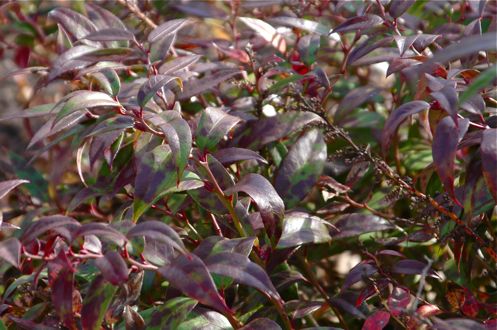My Colorful Black Friday
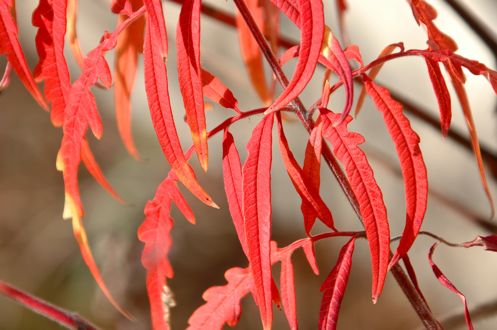
I am not the Black Friday type. A red-blooded consumer, I don’t like being told I’m supposed to go shopping with millions of my fellow shoppers. Last weekend, a rare Thanksgiving holiday with perfect weather, found me hunting for foliage, not deals. I slipped away from guests and feasts to investigate the last gorgeous accents of color in the late fall landscape. In the spirit of Thanksgiving, I honed in on the brightly colored foliage of North American native plants.
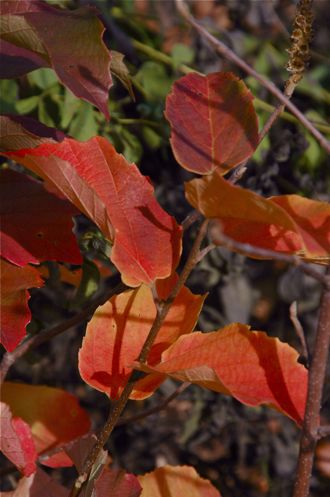
Late coloring shrubs stand out dramatically against surrounding bare twigs and branches. Take, for instance, the sunset-colored leaves of witch alder (Fothergilla) a relation of witch hazels, and named after an 18th century British collector of American plants. There are only two species, both native to the southeast, and one hybrid. They are compact shrubs (f. major is larger), ideal for small gardens as specimens, and for hedges and masses plantings in larger gardens. They are easy to grow because they thrive in average soil, and tolerate full sun to part shade. They are even deer tolerant. I grew fothergilla in shade and hideous soil in Connecticut where, twice annually I regretted not having planted more: First in mid-spring, when it’s faintly fragrant bottle-brush shaped white flowers emerged gloriously from dark twigs, and again in fall when it’s fantastic foliage dominated everything else.
Sumac also caught my eye. It belongs to the Rhus genus, a vast and diverse group of plants that includes cashews, poison oak and poison ivy. Do not recoil, however, from the tamer species like the Staghorn sumac (Rhus typhina), which is native to eastern North America. Growing up to 15 feet tall, it has a loose, open architecture with thick, soft brown suede-ish branches that resemble a stag’s antlers. It produces sizeable flower panicles in early summer, and its seeds, arrayed in an upright irregular cone-like spike, turn dark terracotta red in fall. The cones persist well into winter when they are especially striking after a frost or light snow. Staghorn sumac would be beautiful as a specimen in a small garden, especially combined with evergreens like boxwood and yew to emphasize the coarseness of its long leaves, the color of its trunk and branches, and its absolutely dazzling scarlet-citrus fall color.
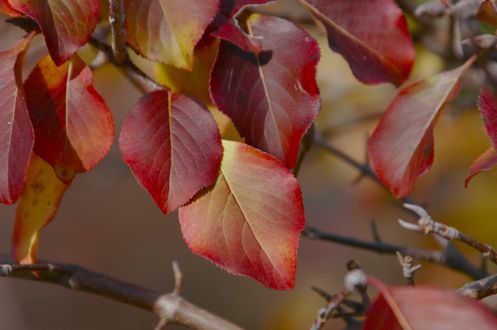
The Blackhaw Viburnum (Viburnum prunifolium) was also coloring up beautifully last weekend. Its diamond shaped leaves are slightly leathery in texture, and display the full spectrum of fall’s colors, a blend of lemony, orangy maroon with a tinge of purple. This tough shrub grows up to 15’ tall, and nearly as wide, and can be grown as a small tree. Either form would work in a small space, but you could also plant them in large masses out on your country estate. Please invite me in spring, to admire the abundant flat, white clusters of tiny, perfect, five-petalled flowers, so attractive to butterflies, and that transform into deep dark violet berries sought out by birds. The Blackhaw Viburnum, native to eastern and central North America, likes average soil and full or part sun, and is drought tolerant. Of interest to growers of black walnut trees, it purportedly tolerates juglans, a chemical generated by black walnut tree roots and is toxic to so many other plants.
I love viburnums, so bear with me. The Arrowwood Viburnum

(Viburnum dentatum) has slightly narrower, pointy leaves that also color late in autumn. Its fall colors vary tremendously: Some shrubs show reds, and others yellowy purpley pink. This very hardy plant could see us through a winter with temperatures in the minus 40’s, and would still bear clusters of white flowers in spring, when it is the last viburnum to bloom. The flowers are tiny and densely packed, and their stamens are unusually long, giving them a soft, fuzzy look. Like many of its’ brethren, the flowers attract a variety of butterflies, and the berries are eaten by birds. A largish shrub, Arrowwood Viburnum can be pruned into a tall hedge, massed, or grown as an individual specimen. I’ve heard that Native Americans used its very straight shoots as arrow shafts, hence the name.
If you have culinary preferences and an appreciation of crimson, you could always pop a blueberry bush or two in your garden. Hardy only to zone 6, mayberries, (vaccinium elliottii) are a kind of blueberry native to southeastern Virginia through Florida, and west to eastern Texas. They endure diverse soil conditions, but prefer acidic soil overall. Mayberries will produce berries most prolifically in full sun, but the plant itself will do well in shade. The flowers emerge in early spring on bare twigs, and are the waxy bell shapes typical to the
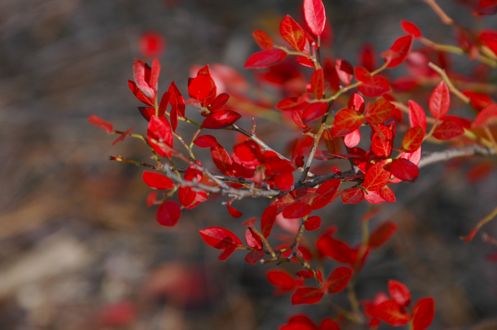
blueberry family, though longer and pinker. Butterflies love them, and the fruits have to be protected from birds if you would like a few for your pancakes. Just remember not to prune blueberries too late in the season because the flowers only grow on the previous year’s new growth. When autumn rolls around, the real show begins, as its fine leaves become a shocking electric cherry-red.
If you have crummy soil and want something easy, try Virginia Sweetspire (Itea virginica), a wide, medium sized shrub that suckers into well-formed mounds. It grows in swampy areas and on pine barrens, from southern New Jersey to Florida and west to Texas, and though it can stand drier locations, it’s not really drought tolerant. Blooming in early summer, its sweet smelling flowers are borne along narrow clusters called racemes, resembling fat, 4 inch pipe cleaners. Most have white flowers but there are charming pink-blooming cultivars, and all attract butterflies. Its pointed, fine leaves, borne on arching branches, are elegant in summer, and in fall burst into a brilliant display of scarlet tinged with maroon and persimmon. It is hard to miss. Virgina sweetspire can be a bit scraggly so will need occaisional pruning, best done after blooming.

Finally, fetterbush is just starting to take on its purplish-green winter color. Growing only about 2-3’ tall and a bit wider, fetterbush (Leucothoe axillaris) is a shade loving plant that likes cool moist soil. Its understated flowers appear in mid to late spring, creamy white bells resembling blueberry flowers that hang in 2-3” clusters all along its branches. Leucothoe, which does not drop its leaves, is especially beautiful as a compliment to smaller, multi-trunked trees like shadblow, sumac, and crepe myrtles where it can be grouped together to provide a richly textured background of green in summer, and purple in winter.
As I think about it, I got the best bargain last Friday – great entertainment for no cost. I hope all my black Fridays will be colorful.
